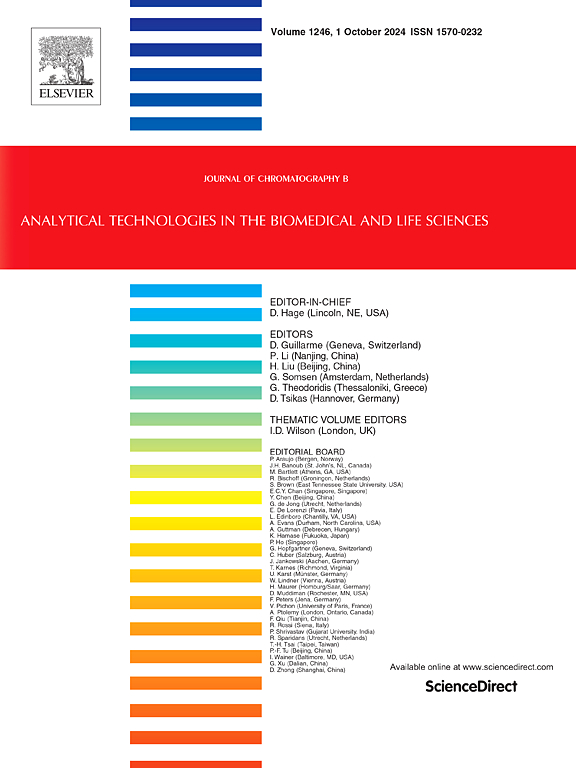Exploring the potential of a quick and simultaneous DoE-based stability indicating novel RP-HPLC method for the estimation of capecitabine and curcumin in biodegradable nanoparticles and human plasma
IF 2.8
3区 医学
Q2 BIOCHEMICAL RESEARCH METHODS
引用次数: 0
Abstract
There is solid evidence that capecitabine (CAP) and curcumin (CUR) can alleviate symptoms of a wide range of illnesses. A fast and specific RP-HPLC method was designed and validated according to ICH requirements, employing an isosbestic point. This technology was chosen for its drug delivery application and synergistic effects of CAP and CUR as no HPLC approach has been documented to estimate and quantify both medicines simultaneously. The mobile phase used for the chromatographic separation was methanol: 0.1 % orthophosphoric acid, (80:20) and the conditions were 1 mL/min flow rate and 332 nm. Shim-pack Solar C18 (4.6 × 250 mm, 5 μm) HPLC column was used for this purpose. With a correlation coefficient value >0.999, the created technique was determined to be linear across the concentration range of 0.25–16 μg/mL. The approach that was created was strong, accurate (with a recovery rate of 91.85–106.53 %), and precise (with a relative standard deviation of <2.0 %). For CAP, the corresponding limits of detection and quantification were determined to be 0.02 and 0.08 μg/mL, whereas for CUR, they were 0.08 and 0.12 μg/mL, respectively. By ICH standards, the proposed approach was also tested in human plasma for validation. In addition, tests were conducted on the stress degradation and the established method's applicability to biodegradable nanoformulation. In the presence of degradation products, there was a good separation of drug peaks. The experimental model was shown to be significant (P < 0.05) after a deliberate adjustment was assessed using analysis of variance. The Quality by Design methodology led to a more accurate procedure that produces consistent, reliable, high-quality data and accurately quantifies CAP and CUR in bulk and nanoparticulate systems.
探索一种快速、同时测定可生物降解纳米颗粒和人血浆中卡培他滨和姜黄素含量的RP-HPLC方法
有确凿的证据表明卡培他滨(CAP)和姜黄素(CUR)可以缓解多种疾病的症状。根据ICH要求,采用等吸点,设计并验证了快速特异的反相高效液相色谱法。选择该技术是因为它的药物传递应用和CAP和CUR的协同效应,因为没有HPLC方法可以同时估计和量化这两种药物。色谱分离的流动相为甲醇:0.1%正磷酸,(80:20),流速为1 mL/min,波长为332 nm。采用Shim-pack Solar C18 (4.6 × 250 mm, 5 μm)高效液相色谱柱。相关系数为>;0.999,该方法在0.25 ~ 16 μg/mL范围内呈线性关系。所建立的方法强、准(回收率为91.85 ~ 106.53%)、精(相对标准偏差为2.0%)。CAP的检测限和定量限分别为0.02和0.08 μg/mL, CUR的检测限和定量限分别为0.08和0.12 μg/mL。根据ICH标准,建议的方法也在人血浆中进行了验证。此外,还进行了应力降解试验,并对所建立的方法在生物降解纳米制剂中的适用性进行了测试。在有降解产物存在的情况下,药峰分离效果良好。实验模型被证明是显著的(P <;0.05),经过刻意调整后,使用方差分析进行评估。质量通过设计的方法导致了一个更准确的程序,产生一致的,可靠的,高质量的数据,并准确量化散装和纳米颗粒系统中的CAP和CUR。
本文章由计算机程序翻译,如有差异,请以英文原文为准。
求助全文
约1分钟内获得全文
求助全文
来源期刊

Journal of Chromatography B
医学-分析化学
CiteScore
5.60
自引率
3.30%
发文量
306
审稿时长
44 days
期刊介绍:
The Journal of Chromatography B publishes papers on developments in separation science relevant to biology and biomedical research including both fundamental advances and applications. Analytical techniques which may be considered include the various facets of chromatography, electrophoresis and related methods, affinity and immunoaffinity-based methodologies, hyphenated and other multi-dimensional techniques, and microanalytical approaches. The journal also considers articles reporting developments in sample preparation, detection techniques including mass spectrometry, and data handling and analysis.
Developments related to preparative separations for the isolation and purification of components of biological systems may be published, including chromatographic and electrophoretic methods, affinity separations, field flow fractionation and other preparative approaches.
Applications to the analysis of biological systems and samples will be considered when the analytical science contains a significant element of novelty, e.g. a new approach to the separation of a compound, novel combination of analytical techniques, or significantly improved analytical performance.
 求助内容:
求助内容: 应助结果提醒方式:
应助结果提醒方式:


